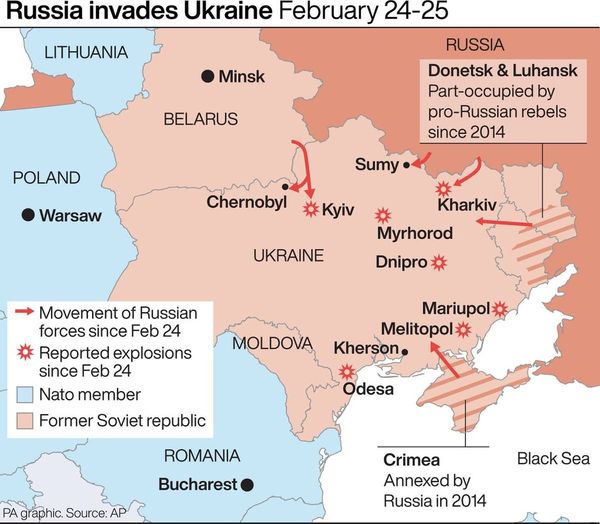Russia’s attack on Ukraine began at about 5am local time, with multiple missile and air raids and a three-pronged invasion from the north, east and south that appeared to be targeting the capital, Kyiv, and the cities of Kharkiv and Kherson respectively.
Hostomel airbase
As of Thursday evening, a fierce battle for the strategic airbase close to Kyiv appeared to be continuing after Russian helicopters and airborne troops attempted to establish a bridgehead outside the city.
Videos on social media – among the most dramatic to have emerged since the invasion began – depicted a swarm of Russian Ka-52 and Mi8 helicopters descending on the Antonov military airfield.
Ukraine said it had downed three helicopters in the initial assault, but a lunchtime report from CNN showed Russian forces in control of at least some of the base. Shortly after, however, Ukraine’s armed forces chief said Kyiv’s forces were fighting back in a critical early battle.
Justin Bronk, of the Rusi thinktank, said if airborne assault troops could take and hold the airbase, the Russians could use it to rapidly build up forces ahead of heavy ground troops to put pressure on the capital. “However, it’s high risk because until ground forces link up, the airborne assault forces are deep in Ukrainian territory and dependent on aerial resupply, casualty evacuation and fire support,” he said.
Chernobyl and the north
A Ukrainian presidential adviser said Ukraine had lost control of the Chernobyl nuclear site in the north, where fighting raged after Russian troops crossed the border from Belarus. The adviser said authorities did not know the current condition of the facilities at the site of the world’s worst nuclear disaster.
Ukraine’s interior ministry warned that if artillery fire was to hit waste stored after the 1986 disaster, it could lead to “radioactive nuclear dust” being spread “over the territory of Ukraine, Belarus and the countries of the EU”.
The Chernobyl exclusion zone lies directly in the path of what western experts believe is the principal invasion route from Belarus to the west of Kyiv, where Ukraine’s presidential palace and key buildings are located.
Russian troops also advanced from the north on the city of Chernihiv. One axis of advance appears to have centred around the Senkivka border crossing to the north-east of Chernihiv. Crucial, perhaps, in this calculation is the fact that south of Chernihiv – which lies to the east of the Dnieper river – lies the E95 highway to Kyiv.

Kharkiv and the east
A substantial attack appeared aimed towards the eastern city of Kharkiv, which has a population of more than 1 million. Multiple reports from Kharkiv described explosions nearby – while Ukraine’s defence ministry said mid-morning that “fierce fights” were taking place in that area.
Andriy Zagorodnyuk, Ukraine’s former defence minister, said Russian forces were trying to surround Kharkiv. “It seems like Kharkiv at the moment is the main target,” he said.
Kherson and the south
Russian forces heading north into Ukraine from Crimea were not meeting any obvious resistance, at least initially. Border guards released security camera footage on Thursday showing a line of Russian military vehicles crossing into Ukraine’s government-held territory from Russian-annexed Crimea.
Social media footage appeared to show Russian forces reaching the city of Kherson on the Dnieper, 80 miles (130km) inside Ukraine. Shortly after, around lunchtime, the presidential adviser said fierce fighting was taking place there.
Film posted online was said to show Russian helicopters over the nearby Kakhovka hydroelectric power plant. Russian forces had also moved north-eastwards from Crimea to Melitopol, where the presidential adviser said they would meet resistance.
Zagorodnyuk said: “They are quite close to the city of Kherson now. The situation is really critical there.”
Missile strikes
Air and missile strikes appear so far to be mostly focused on military targets, including an air defence site in the frontier down of Mariupol, the Ukrainian naval base in Ochakiv and an arms depot in Kalynivka, 124 miles (200km) south-west of Kyiv, according to the defence intelligence specialists Rochan Consulting.

Russia’s defence ministry said its forces had destroyed 74 “objects of above-ground military infrastructure”, though this could not be confirmed. The US said it believed Russia launched 100 missiles and used 75 aircraft in the first wave of bombing.
Casualties
Information on casualties has been hard to verify, though on Thursday evening Ukraine’s health minister said 57 people had been killed and 169 injured.
Ukraine’s armed forces earlier reported that at least 40 soldiers had died. The Ukrainian presidential adviser said up to 10 civilians had been killed. The mayor of Mariupol said three civilians had been killed there and emergency services in Kharkiv said a boy had been killed after shelling struck an apartment building. The local administration in Odesa said 22 people had died in a strike on a military base.
How the militaries compare
Russia has amassed more than 150,000 combat troops on the borders of Ukraine, with a further 34,000 lightly armed separatist forces in the pro-Russian self-proclaimed republics in Donetsk and Luhansk. That amounts to an estimated two-thirds of Russia’s total ground forces. Half of Moscow’s air force is also deployed in the region.
Ukraine’s forces are considerably smaller. It has a regular army that numbers 125,600, according to the International Institute for Strategic Studies, but has mobilised reserves of at least 36,000.
Some of the Russian ambition has been aimed explicitly at demoralising Ukrainian civilians with the reach of the offensive. While much of the initial barrage was aimed at the east of Ukraine, so far, more sporadic strikes on cities in the west, from Uman to Lutsk and Ivano-Frankivsk, seem designed to demonstrate the reach of Russian weapons.










